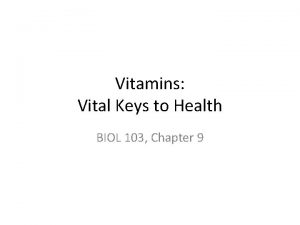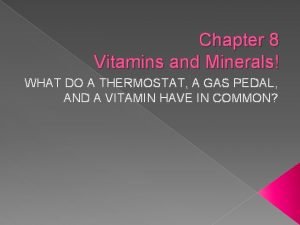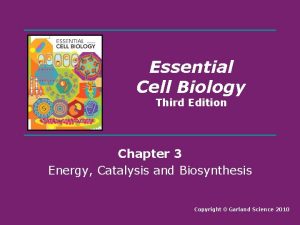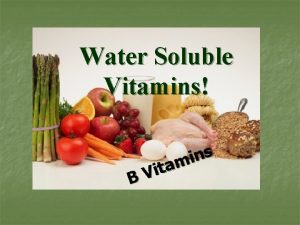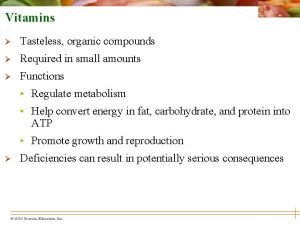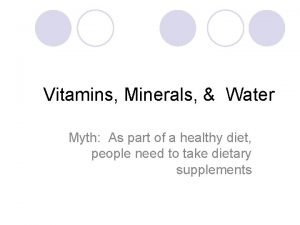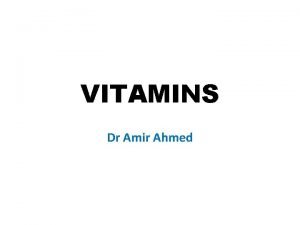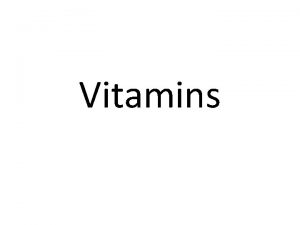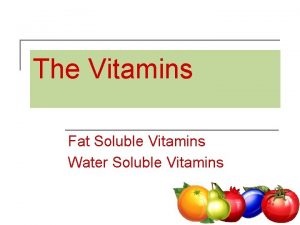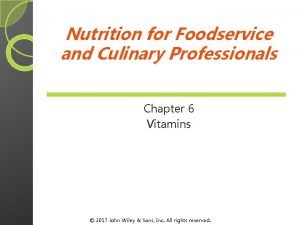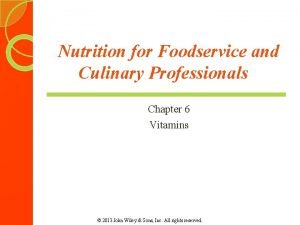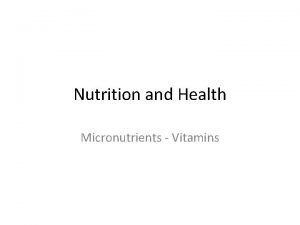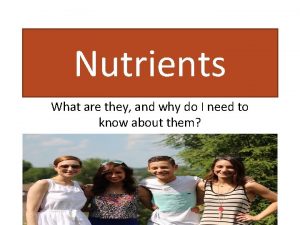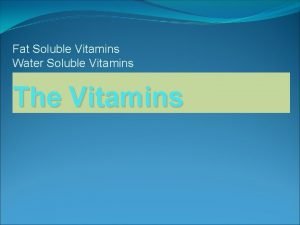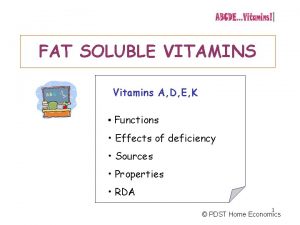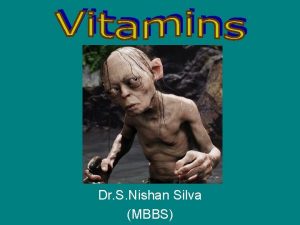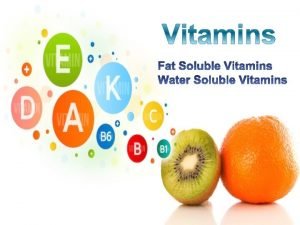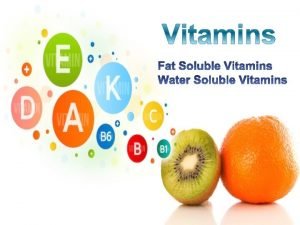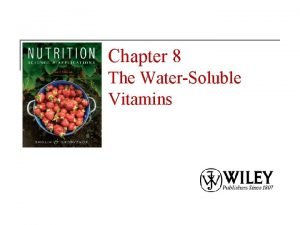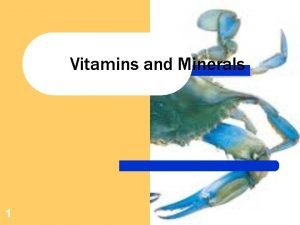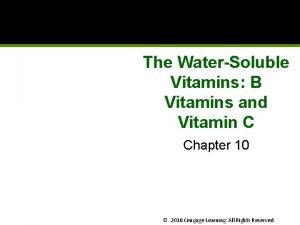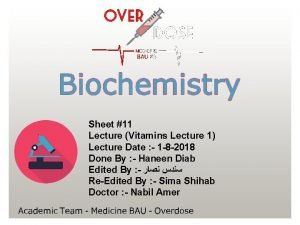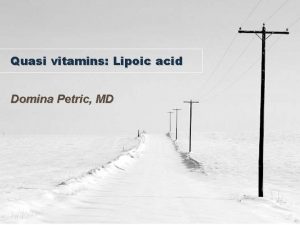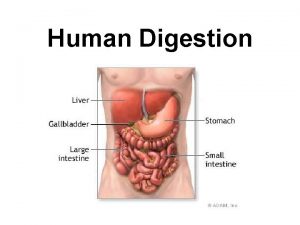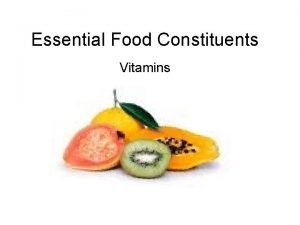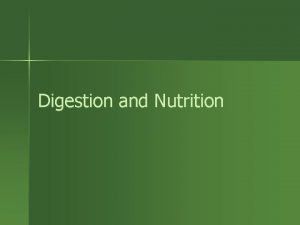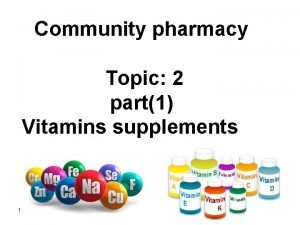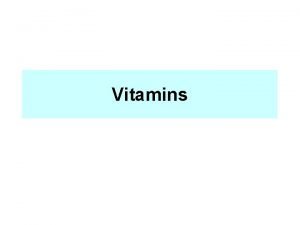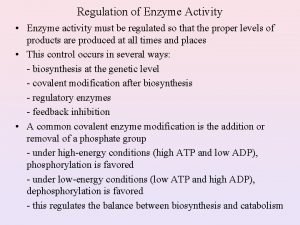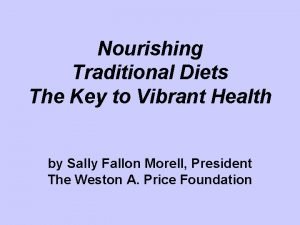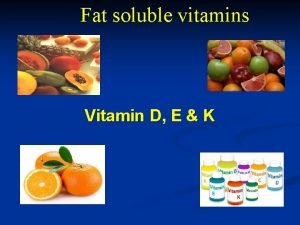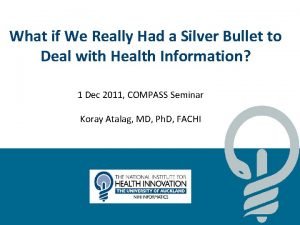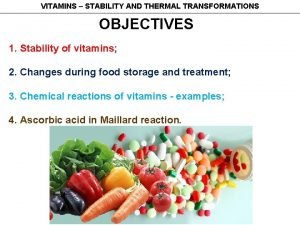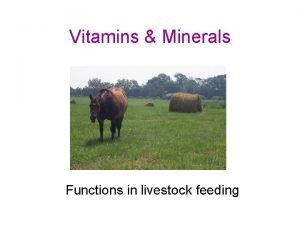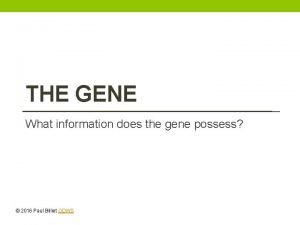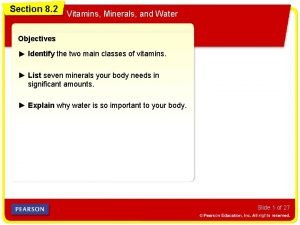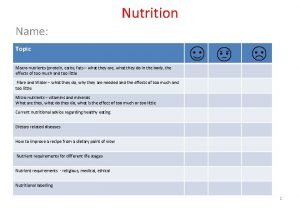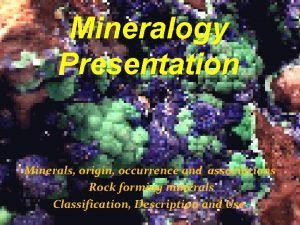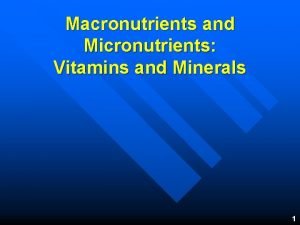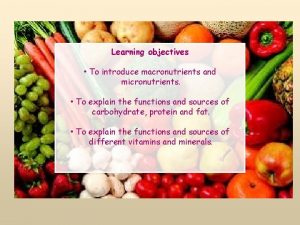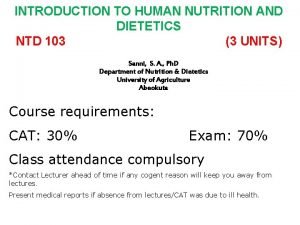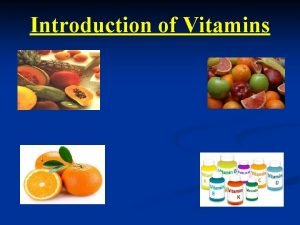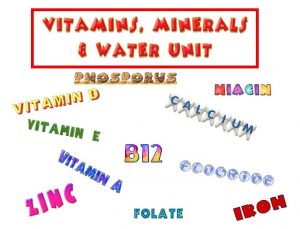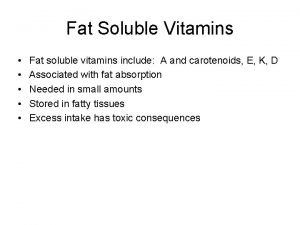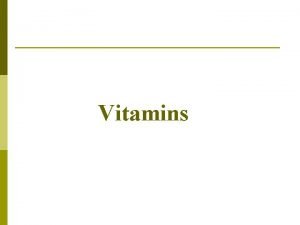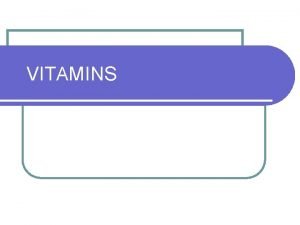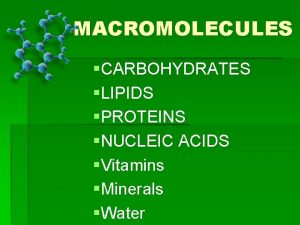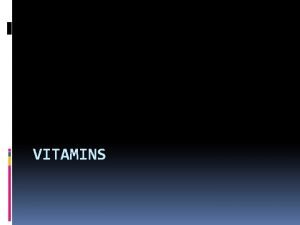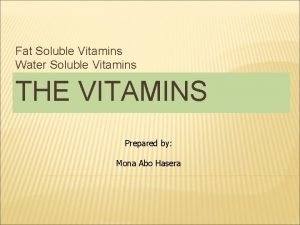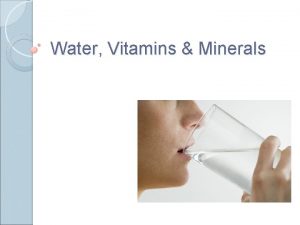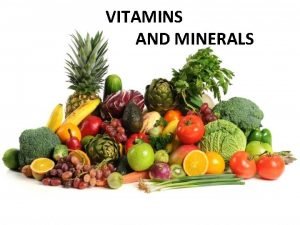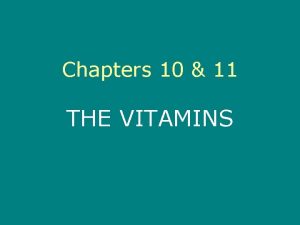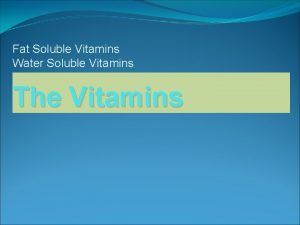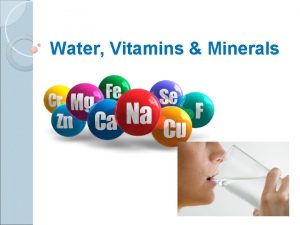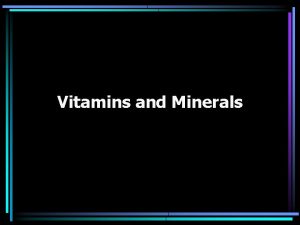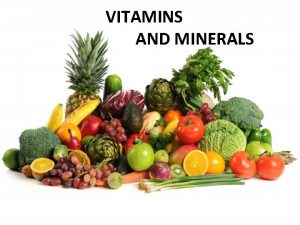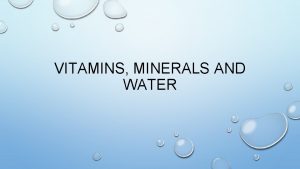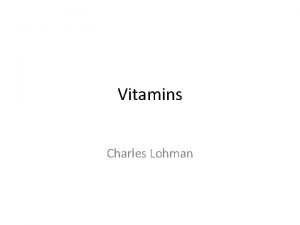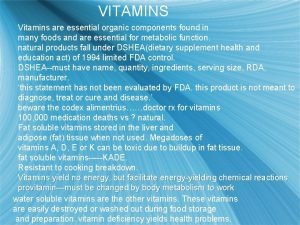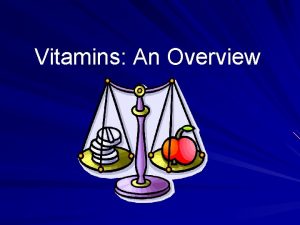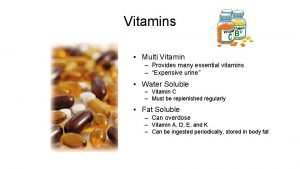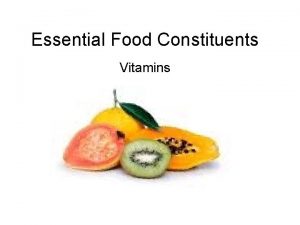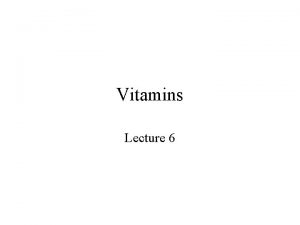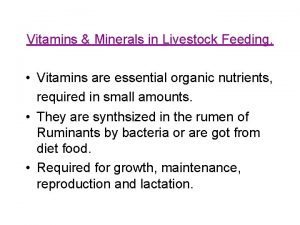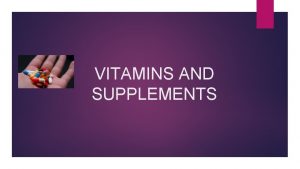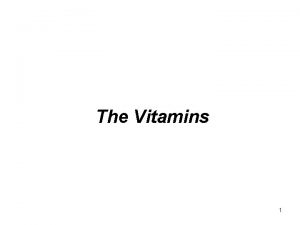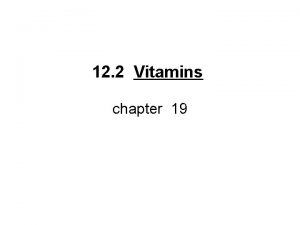Chapter 8 Vitamins What are Vitamins n Essential












































































- Slides: 76

Chapter 8 Vitamins

What are Vitamins? n Essential organic substances n Produce deficiency symptoms when missing from diet n Yield no energy n Basic functions – Facilitate energy-yielding chemical reactions – Function as co-enzymes n Fat-soluble vitamins n Water-soluble vitamins

Fun Facts n Vitamins were named in order of discovery (A, B, C, D, …) n Other substances found not to be essential were dropped (e. g. , vitamin P) n B-vitamins were thought to be one vitamin; turned out to be many (e. g. , B 1, B 2, B 3, …)

Vital Dietary Components n Megadose (>3 -10 x needs as a starting point) – Proved useful in treating certain conditions n Plant and animal foods provide vitamins n Most synthesized vitamins work equally well in the body vs natural n Scientists believe they have discovered all the vitamins

Storage of Vitamins in the Body n Fat-soluble – Not readily excreted (except vitamin K) n Water-soluble – Generally lost from the body (except vitamins B-6 and B-12) – Excreted via urine n Vitamins should be consumed daily – Occasional lapse is harmless

Vitamin Toxicity n Fat-soluble vitamins (e. g. Vitamin A) – Can accumulate in the body n Water-soluble vitamins – Some can cause toxicity n Mostly likely due to supplementation

Preservation of Vitamins n Decreased vitamin content – Improper storage – Excessive cooking >40*C – Exposure to light, heat, air, water, and alkalinity Eat foods soon after harvest (EAT FRESH) n Freeze foods not consumed within a few days n Blanching destroys enzymes (bacteria) n – Slows down vitamin degradation

Preservation Tips

Fat-Soluble Vitamins Overview Dissolve in organic solvents n Not readily excreted n – Can cause toxicity Olestra Absorbed along with fat n Fat malabsorption (Xenical/Olestra) n – May cause deficiency – Cystic fibrosis (Vit. deficiency) n Transported with fat – In lipoproteins Xenical

Confirming your knowledge What are the fat Soluble vitamins, why (i. e. non polar)? 1 3 2 4

Vitamin A n Narrow optimal intake range n Preformed – Retinoids – Found in animal products (fish/organ meats) n Proformed (pro. Vitamin A) – – – Carotenoids Found in plant products Can be converted to Vit A by the body B carotene

Functions of Vitamin A n Promote vision – Night blindness n Promote growth n Prevent drying of the skin and eyes – Xerophthalmia (figure 8 -1) & macular degeneration n Promote immune function and resistance to bacterial infection n Cardiovascular disease prevention (b/c antioxidant) n Cancer prevention (antioxidants and other) n Acne medication (Retin-A, Accutane)

Challenge Question n What is the name following compound (which has been shown to reduce prostate cancer risk) and what are good sources? Gann et al. , 1999, Cancer Research, 59, 1225

Food Sources of Vitamin A: see: 8 -2

Recommended Amounts for Vitamin A g RAE for men n 700 g RAE for women n Daily Value is 1000 g (RAE) ~ 5000 IU n Upper Level is 3000 g, 10, 000 IU n Much stored in the liver n No separate RDA for carotenoids n 900

Toxicity of Vitamin A n Large intake of vitamin A (preformed) – Over a long period – Use of Accutane and Retin-A ≥ 10, 000 IU or 3000 RAE n Signs and symptoms – Bone/muscle pain, loss of appetite, skin disorders, headache, dry skin, hair loss, increased liver size, vomiting – Fetal malformation (binds to DNA cell develop. ) – Possible permanent damage (infants) – < 3000 IUs/day if pregnant

Vitamin D n Prohormone n Derived from cholesterol n Synthesized from sun exposure – Sunscreen SPF >8 decreases synthesis 95% – Expose hands, face, arms 2 -3 x/week for 5 -10 minutes each time (more for darker skin) n Insufficient sun exposure makes this a vitamin n Activated by enzymes in liver and kidneys n Deficiency can cause disease

Activation of Vitamin D

Functions of Vitamin D n Regulates blood calcium – Along with the parathyroid hormone – Regulates calcium + phosphorus absorption – Reduces kidney excretion of calcium – Regulates calcium deposition in bones n Influences normal cell development – Linked to reduction of breast, colon, and prostate cancer

Role in Bone Formation n Causes calcium + phosphorus to deposit in the bones n Strengthens bones n Rickets is the result of low vitamin D – Breastfed infants with little sun exposure n Osteomalacia (soft bones) – Rickets-like disease in adults – Bones lose minerals and become porous

Challenge Question n According to the USDA and ODS – Vitamin D is now considered a deficiency in N. American diets – what are the two major reasons? n 1. n 2.

Food Sources of Vitamin D n Fatty fish (salmon, herring) n Fortified milk (N. fat, Low fat or Whole) n Some fortified cereal

Adequate Intake (AI) for Vitamin D g/day (200 IU/day) for adults under age 51 n 5 g/day (400 - 600 IU/day) for older adults n 10 -15 n Supplement if a breastfed – (See physician for details) infant

Toxicity Warning n Vitamin D can be very toxic, especially in infancy and childhood n Upper Level is 50 µg/day n Results in – Over-absorption of calcium (hypercalcemia), increase calcium excretion – Calcium deposits in organs (kidneys) & blood vessels – Growth retardation

Vitamin E Fat-soluble antioxidant n α β δ gamma tocopherol forms n n Resides mostly on cell membranes

Other Functions of Vitamin E n Protects double bonds in unsaturated fats n Improves vitamin A absorption n Deficiency – Breakdown of cell membranes – Hemolysis – Nerve degeneration n RDA for adults is 15 mg/day – Many adults are not meeting this goal

Food Sources of Vitamin E

Toxicity of Vitamin E Upper Level is 1, 000 mg/day (supplementary alphatocopherol) n Upper Level is 1500 IU (natural sources) or 1100 IU (synthetic forms) n n Adivse mixture of natural tocopherols (vs synthetic sources) (400 IUs) n Toxic effects – – – Inhibit vitamin K metabolism and anticoagulants Possible hemorrhage Muscle weakness, headaches, nausea

Vitamin E n SHOW Vit E video

Vitamin K (“Koagulation”) n Synthesized by bacteria in the colon (10%) and absorbed (diet) Frequent anti-biotics deficiency. . . n Role in coagulation process (fig 8 -10) n Role in calcium-binding potential

Food Sources of Vitamin K n Liver n Green leafy vegetables n Broccoli n Peas n Green beans n Resistant to cooking losses n Limited vitamin K stored in the body (<24 hr)

Adequate Intake for Vitamin K 90 µg/day for women n 120 µg/day for men n Excess vitamins A and E n – Interferes with vitamin K – May cause hemorrhage and fractures n Newborns – Routinely injected with vitamin K – Breast milk is a poor source Toxicity unlikely; readily excreted n High Levels CVD, prevent reduced clotting n

Overview of Water-Soluble Vitamins n n n n Dissolve in water Generally readily excreted from body Subject to cooking losses Function as coenzymes Participate in energy metabolism 50 -90% of B vitamins are absorbed Marginal deficiency more common U. S. Enrichment Act (grains milled loose vitamins. . ) – Must be added back (enriched) to products (cereals) n Why experts recommend whole grains/brown rice vs Refined grain products

Confirming your Knowledge Overview of Water-Soluble Vitamins n What are the water soluble vitamins and why (i. e. polar) ? (3) (2) (1) (5) (4) (6) (9) (7) (8)

Overview of Water-Soluble Vitamins Participate in energy metabolism

Thiamin n Sensitive to alkalinity (base) and heat n Coenzyme form used in energy metabolism n Deficiency: Beriberi (severe muscle weakness n RDA – 1. 1 mg/day for women – 1. 2 mg/day for men – Most exceed RDA in diet n Surplus is rapidly lost in urine; non-toxic

Food Sources of Thiamin, fig. 8 -14

Riboflavin n Coenzyme forms participate in energyyielding metabolic pathways n Deficiency – Cheilosis, inflammation of mouth and tongue, dermatitis, sensitivity to sun n RDA – 1. 1 mg/day for women – 1. 3 mg/day for men – Average intake above RDA n Non-toxic

Food Sources of Riboflavin n Milk/milk products n Enriched grains/cereals n Eggs n Liver n Spinach n Oysters n Brewer’s yeast

Niacin n Coenzyme forms used in energy metabolism n Deficiency – Pellagra: rough/painful skin (epidemic US < 1930 s) – Dementia, diarrhea, dermatitis, n RDA – 14 mg/day for women – 16 mg/day for men n Toxicity – Upper Level is 35 mg/day

Food Sources of Niacin n Enriched grains (breakfast cereals) n Beef n Chicken/turkey n Fish n Heat stable; little cooking loss n 60 mg tryptophan (Amino acid) can be converted into 1 mg niacin

Pantothenic Acid n Part of Coenzyme-A – Essential for metabolism of carbohydrate, fat, and protein n Deficiency rare – Usually in combination with other deficiencies

Food Sources of Pantothenic Acid n n n n Meat Milk Mushrooms Liver Peanuts Adequate Intake = 5 mg/day Average intake meets AI

Biotin n Free and bound form n Co-enzyme – Metabolism of carbohydrate and fat – Helps breakdown certain amino acids n Deficiency–rare – Scaly, inflamed skin – Changes in tongue, lips – Decreased appetite, nausea, vomiting

Food Sources of Biotin n Cauliflower, egg yolk, liver, peanuts, cheese n Intestinal synthesis of biotin contributes very little (10%) n Avidin egg protein inhibits absorption – More than a dozen raw egg whites a day to cause this effect

Biotin Needs n Adequate adults n No intake is 30 µg/day for Upper Level for biotin n Relatively nontoxic

Vitamin B-6 n Coenzyme forms – Activate enzymes needed for metabolism of carbohydrate, fat, and protein – Synthesize nonessential amino acids via transamination – Synthesize neurotransmitters – Synthesize hemoglobin and WBC

Food Sources of Vitamin B-6, fig. 8 -22

RDA for Vitamin B-6 n 1. 3 mg/day for adults n 1. 7 mg/day for men over 50 n 1. 5 mg/day for women over 50 n Daily Value set at 2 mg n Average intake is more than RDA n Athletes may need more n Alcohol increases vitamin B-6 destruction

Vitamin B-6 As a Medicine? n 50 -100 mg/day therapy – Questionable treatment of PMS – May treat pregnancy hypertension n Carpal tunnel syndrome n Morning sickness – (100 mg/day may help; see Ch. 13) n Toxicity potential – > 200 mg/day can lead to irreversible nerve damage n Upper Level set at 100 mg/day

Folate n Coenzyme – DNA synthesis – Homocysteine metabolism – Neurotransmitter formation n Sensitive to: – Heat, oxidation, ultraviolet light

n Megaloblastic Anemia n 10% N. Americans- genetic defect to process Folate Deficiency folate (req. 2 X RDA), need genetic testing. . n Neural tube defects n Women need ample Folic acid: – Neural tube closes w/i 28 days of pregnancy spinal bifuda

n. Megaloblast cells -Req. ample Folic acid

Child bearing Women need ample Folic acid: Neural tube closes w/i 28 days of pregnancy spinal bifuda

Food Sources of Folate n Liver n Fortified breakfast cereals n Grains, legumes n Foliage vegetables n Orange juice

RDA for Folate n 400 µg/day for adults n 600 µg/day for pregnant women n Excess intake can mask vitamin B-12 deficiency n Upper Level 1 mg (synthetic form) – Synthetic form 1. 7 X more potent. . . – Folate in food has limited absorption (synthetic form) (Natural form)

Vitamin B-12 Synthesized by bacteria and fungi n Coenzyme n – – – n Role in folate metabolism Maintenance of the myelin sheaths RBC formation Deficiency (absorption problems) – Pernicious anemia (weakness, sore tongue, back pain) – Nerve degeneration and paralysis

B-12 Absorption -aging n Requires a protein from salivary gland n Requires stomach acid (declines w/ age) n Requires the intrinsic factor (declines w/ age) n Absorbed in the last part of the small intestine n About 50% of B-12 is absorbed n Vegetarian/Vegan diets – low in Vit. B-12 – (need supplement or specified rich source)

Therapy for Ineffective Absorption n Many factors can disrupt this process n Monthly injections of vitamin B-12 n Vitamin B-12 nasal gel n Megadoses of vitamin B-12 – Allow for passive diffusion

Food Sources of Vitamin B-12 n n n n n Synthesized by bacteria, fungi and algae (Stored primarily in the liver of animals) Animal products Organ meat Seafood Eggs yogurt Milk Corn flakes cereal (w/ soy milk)

RDA for Vitamin B-12 n 2. 4 µg/day for adults – Over age 50 recommended take synthetic form – Not bound to foods (no require low stomach acid) n Average intake exceeds RDA n B-12 stored in the liver (> 3 years before deficiency) n Non-toxic

Vitamin C n Synthesized by most animals – Not by humans n Decreased absorption with high intakes > 250 mg n Excess excreted – Diarrhea common n Sensitive to – Cooking/heat (high temp) ~ use medium setting – Iron, copper, oxygen

Functions of Vitamin C n Synthesis of collagen (connective tissue) – Stretch marks n Iron absorption n Immune functions – Prevents duration of common cold? – Interacts with w/ oxidized Vit. E ~ recycles? – Anti-cancer agent and cataracts n Antioxidant? n Req. for syn. Of hormones

Challenge Question What has more Vitamin C/gram and is the best dietary choice for combating the common cold and why? n 1 medium orange n 1 medium red pepper

Deficiency of Vitamin C n Scurvy – Deficient for 20 -40 days – Fatigue, pinpoint hemorrhages – Bleeding gums – Weakness – Fractures – Associated with poverty

Food Sources of Vitamin C n Citrus fruits n Potatoes n Green pepper n Cauliflower n Broccoli n Strawberries n Romaine lettuce n Spinach

RDA for Vitamin C n n n n 90 mg/day for adult males 75 mg/day for adult females (enhances Fe absorptn. ) Daily Value is 60 mg +35 mg/day for smokers Average intake 70 -100 mg/day Upper Level is 2 g/day (inflammation diarrhea) Better to take low doses (250 mg) more frequent vs Mega. DOSE 1 Gram (1000 mg) / day

Choline n Essential nutrient, though not a vitamin n All tissues contain choline n Precursor for acetylcholine (neurotransmitter) n Precursor for phospholipids

Food Sources of Choline n Widely distributed in foods – Fruits/vegetables n Milk n Liver n Eggs n Peanuts n Lecithin added to food n Deficiency rare

Needs for Choline n Adequate Intake is 550 mg/day for males n Adequate Intake is 425 mg/day for females n Average intake is ~700 -1000 mg/day n High doses – Associated with fishy body odor, vomiting, salivation, sweating, hypotension, GI effects n Upper Level is 3. 5 grams/day

Vitamin-like Compounds n Choline n Carnitine n Inositol n Taurine n Lipoic acid n Synthesized in the body at the expense of amino acids and other nutrients

Vitamins-SUMMARY Functions in the Body With a balanced diet – no need for supplements?

Dietary Supplements $21 Billion

Dietary Supplements –Classified as n Vitamins n Minerals Fe 2+ n Herbs n Amino Acids n A dietary substance to supplement the diet n Try a case study?


Vitamins, Supplements SUMMARY n n If going to experiment. . . Make sure < (upper limit) of toxic level Min. 6 weeks for evaluation. . . ANY SUPPLEMENT QUESTIONS? See below n Check any of the following 6 websites for validity – 1. www. acsh. org – 2. www. quackwatch. com – 3. www. ncahf. org – 4. http: //dietary-supplements. info. nih. gov – 5. www. eatright. org – 6. www. usp. org/USPVerified/dietary. Supplements/ **7. “web of science”- (use UCSC Lib login, § http: //oca. ucsc. edu/login (22200 -0230485 -15)
 Antigentest åre
Antigentest åre Water soluble vitamins vs fat soluble vitamins
Water soluble vitamins vs fat soluble vitamins Characteristics of lipids
Characteristics of lipids Chapter 8 vitamins and minerals
Chapter 8 vitamins and minerals Signal transduction
Signal transduction It essentials
It essentials It essential chapter 8
It essential chapter 8 It essentials chapter 5
It essentials chapter 5 It essential chapter 5
It essential chapter 5 It essential chapter 12
It essential chapter 12 It essentials chapter 9
It essentials chapter 9 Chapter 11 quiz it essentials
Chapter 11 quiz it essentials Chapter 2 essential chemistry for biology
Chapter 2 essential chemistry for biology Essential cell biology
Essential cell biology Water soluble vitamins characteristics
Water soluble vitamins characteristics Where vitamins are absorbed
Where vitamins are absorbed Minerals sources functions and deficiency chart
Minerals sources functions and deficiency chart Vitamins name
Vitamins name Are vitamins organic compounds
Are vitamins organic compounds Vital+amine
Vital+amine Manaquinone
Manaquinone The chef does everything but cook that's what wives are for
The chef does everything but cook that's what wives are for Categories of vitamins
Categories of vitamins Orange vegetables list
Orange vegetables list Vitamins functions
Vitamins functions Classes of food with pictures
Classes of food with pictures Functions of vitamins
Functions of vitamins Difference between water soluble and fat soluble vitamins
Difference between water soluble and fat soluble vitamins Water soluble vitamins adek
Water soluble vitamins adek تعريف الفيتامينات
تعريف الفيتامينات Characteristic of vitamin
Characteristic of vitamin Characteristics of water soluble vitamins
Characteristics of water soluble vitamins Water soluble vitamins
Water soluble vitamins Nature of vitamins
Nature of vitamins Excess b vitamins urine
Excess b vitamins urine Vitamins and their deficiency
Vitamins and their deficiency Domina petric
Domina petric Types of vitamins
Types of vitamins Importance of vitamins
Importance of vitamins Functions of the large intestine
Functions of the large intestine Vitamin part1
Vitamin part1 Asea source
Asea source Do vitamins yield energy
Do vitamins yield energy Thiamin
Thiamin Hemoragea
Hemoragea Primitiv vitamins
Primitiv vitamins Food pyramid carbohydrates fats proteins vitamins minerals
Food pyramid carbohydrates fats proteins vitamins minerals A d e k vitamin
A d e k vitamin Water soluble vitamins
Water soluble vitamins When to take supplements chart
When to take supplements chart Objectives of vitamins
Objectives of vitamins Conclusion of vitamins
Conclusion of vitamins Vitamins classification chart
Vitamins classification chart Vitamins conclusion
Vitamins conclusion Objectives of vitamins
Objectives of vitamins Vitamins sources functions and deficiency chart
Vitamins sources functions and deficiency chart Kyanite formula
Kyanite formula Is vitamin c a macronutrient or micronutrient
Is vitamin c a macronutrient or micronutrient Learning outcomes should be
Learning outcomes should be Ntd nutrition
Ntd nutrition Xerophthalmia stages
Xerophthalmia stages Water soluble vitamins chart
Water soluble vitamins chart Digestion vitamins
Digestion vitamins Celiac beri beri
Celiac beri beri Vitamins definition and classification
Vitamins definition and classification Site:slidetodoc.com
Site:slidetodoc.com Westward expansion essential questions
Westward expansion essential questions Essential clothing limited
Essential clothing limited Essential unified process
Essential unified process Who is the author
Who is the author Laws of friction
Laws of friction Drdp preschool essential view
Drdp preschool essential view 6 essential elements
6 essential elements The six essential elements of geography
The six essential elements of geography Renaissance essential questions
Renaissance essential questions Pythagorean theorem essential questions
Pythagorean theorem essential questions Production sheets food service
Production sheets food service

